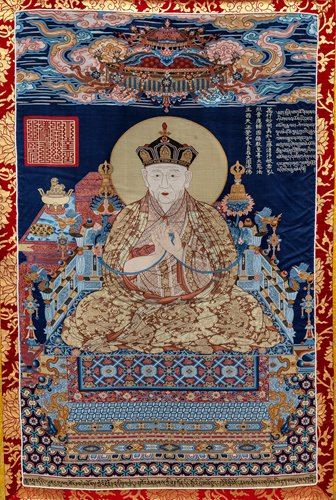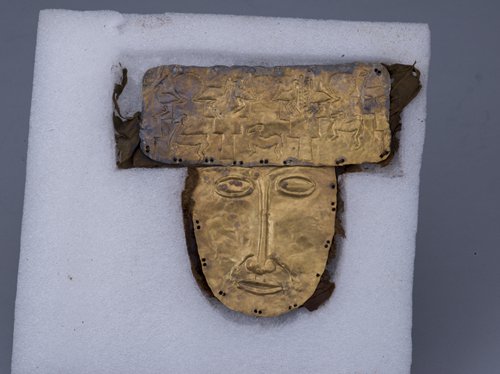
A replica of a Ming Dynasty thangka (Photo/Courtesy of Capital Museum)

The Zhang Zhung gold mask (Photo/Courtesy of Capital Museum)
The history of the Southwest China's Tibet Autonomous Region may seem complicated to those who don't know much about the region. Fortunately, a Beijing exhibition is helping to clear up the mysteries surrounding the region's culture and its roots.
The exhibition Tibetan History and Culture that kicked off at the Capital Museum on Tuesday features 216 extremely rare items from 21 museums throughout China, including a 3rd century gold mask from the ancient Tibetan kingdom Zhang Zhung and a 4.3-meter-high 15th Century embroidered thangka.
Many of the exhibits are being exhibited outside Tibet for the first time.
"This is the biggest Tibetan exhibition held in Chinese mainland in a decade," Pasang Nurpu, head of the exhibition department at the Tibet Museum and one of the organizers of the event, told the Global Times at Tuesday's exhibition.
Highlights
The exhibition is organized into four sections: Origins of Civilization, which focuses on prehistoric Tibet; Major Links on the Plateau, covering ancient Tibet's relationship with the Middle Kingdom and surrounding countries; Buddhist history in Tibet and Reunited as A Family, which delves into how the ties between Tibet and the Ming (1368-1644) and Qing dynasties (1644-1911) strengthened over the centuries.
One of the biggest highlights of the show comes from the Palace Museum collection - a legendary Tang Dynasty (618-907) scroll painting by Yan Liben (600-673) that depicts Emperor Taizong sitting in a sedan chair carried by palace servants as he receives missionaries from the ancient Tibetan Kingdom of Tubo.
The well-painted Tibetan clothing depicted on the missionaries provides a valuable window into the past for experts studying Tibetan history and culture, according to the organizers.
Known as Emperor Taizong Receiving the Tibetan Envoy, or the Buniantu, the 1.3-meter-long painting shown in the Major Links on the Plateau section is listed as one of the Top Ten Ancient Chinese Paintings and "is rarely shown to the public even at the Palace Museum," said Palace Museum curator Shan Jixiang, who also visited the exhibition on Tuesday.
The painting is scheduled to be on display for just two months at the Capital Museum exhibition, which runs until July, due to its extreme age making it extremely delicate.
Aside from the legendary scroll, Nurpu said he recommends that visitors start with the Origins of Civilization section.
"Though this section has fewer items on display than the others, it actually showcases some of the latest archaeological discoveries made in Tibet in recent years. These are rarely shown to the public even in Tibet," Nurpu told the Global Times.
"In the past, most people only had the chance to learn about early Tibetan history and culture from about 2,000 years ago only from historical texts, but now they can get a more concrete idea about the history of the region by coming to this show and examining these relics themselves," Nurpu noted.
In this section, the magnificent Zhang Zhung gold mask, a pinch of the oldest tealeaves ever found on the Qinghai-Tibet Plateau dating back to the 3rd century, the earliest brocade item found in Tibet featuring Han characters and a local Neolithic twin pottery container - the most popular item from the Tibet Museum - are definitely worth careful examination.
Changing history
Moreover, there are also a number of important items on display in the other three sections that you may not want to miss.
A collection of centuries-old jewelry-gilded horse saddles and exotic gold tea pots shown in the Major Links on the Plateau section shows how "Tibetan culture was influenced by frequent exchanges with inlands and foreign countries along the ancient Tea Horse Road," Nurpu said, mentioning the ancient network of caravan paths winding through the mountains of Sichuan, Yunnan and Tibet in Southwest China.
Moreover, a series of sophistically made Buddhist artifacts from Tibetan museums and temples are on display in the Buddhist History in Tibet section. Among them, a number of multi-colored, jewelry-gilded Buddha sculptures produced by Xueduibai, an official local workshop run by the regional government during the Qing Dynasty, amazed and attracted many visitors.
These items show how Buddhism blended with Bonisimo, a local religion, after it was first introduced into Tibet by the Tang Dynasty Princess Wencheng. The princess was married to Songtsen Gampo, founder of the Tubo Kingdom, in the 7th century.
In Reunited as a Family, a number of imprints that once belonging to Tibetan rulers during the Qing Dynasty as well as a letter sent by a local temple to a Qing emperor demonstrate how the region's ruling power gradually moved from local aristocrats to the Dalai Lama and how Qing's official recognition of the religious leader's status helped reinforce his political power.
The exhibition will run until July 22.
Exhibition info
●You can take a bus or Metro Line 1 to the Capital Museum, No 16 Fuxing Menwai Street, Xicheng district, Beijing. The museum opens from 9 am to 5 pm (no admission after 4 pm) every day except for Monday.
●The exhibition is free of charge but you must book tickets in advance through the museum's website: http://en.capitalmuseum.org.cn/


















































